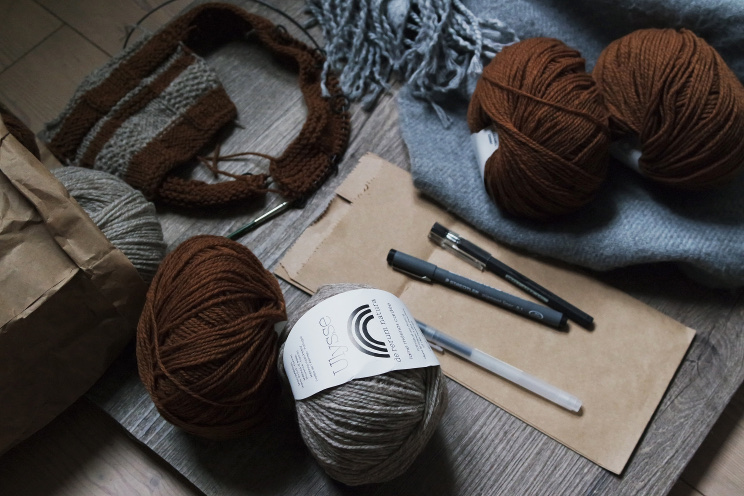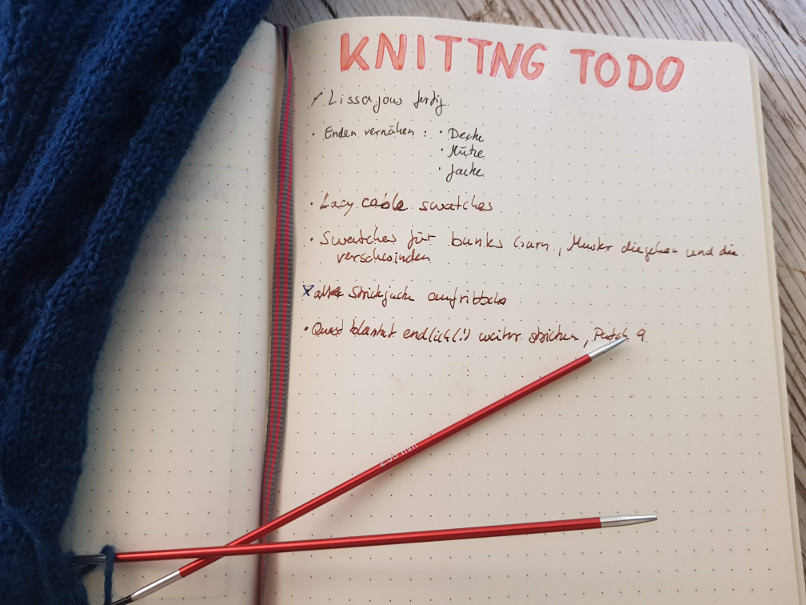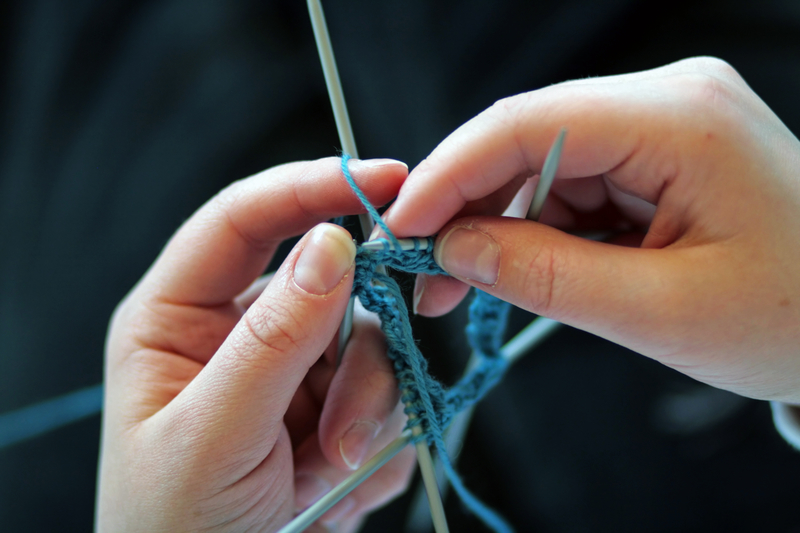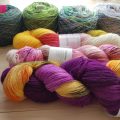A while ago I received a question about how one could better divide their time between multiple knitting projects. I replied with a few quick ideas and tips, but I thought it would make an excellent subject for the blog. So I did some more research. And apparently, there isn’t that much find on the subject of time management and knitting. A few tidbits here and there but nothing more concrete. I thought that was funny considering so many of us often complain that they don’t manage to finish their projects (or presents) on time.
I suppose that lies in the nature of things, though. Knitting is a creative thing. And many (not all) creative people dislike planning. We often feel caged in by the plans we make, instead of unburdened. (See the whole discussion about pantsers versus plotters in writing, for example.)
But while it makes sense to plan other creative endeavors (like writing, programming and such), you don’t have to do this with knitting. It all depends on what you need and what you are looking for.

When Planning Your Knitting Projects Might Help You
Do you feel you never finish any projects? Do you feel unproductive or stressed out? Did you want to knit a sweater for winter but still have it lying around unfinished the following summer? Then you may profit from trying to plan your knitting.
Similarly, it might help you if you need to finish a project (or multiple ones) by a specific deadline. Quite a few prolific knitters have started planning their Christmas knitting (and other chores). But don’t over complicate things, that will only add more stress instead of taking it away. Stick to the simplest solution that works for you. You will have a higher chance of success and of sticking to planning and your plan, in general, that way. If need be, you can always tweak your method later and add or change things. There are many ways to manage your knitting time. And you only need to find the one that works best for you.
You don’t feel unproductive? Aren’t bothered by your UFOs or don’t have any deadlines? Then you don’t need to plan! Do what works for you and what makes you feel comfortable. If you aren’t stressed out, there is no need to change anything. Knitting is not (usually) a speed competition, and there is no need to compare your output to that of others.
And you also don’t need to feel that you need to plan your knitting all the time, just because you started it once. Only do it when you feel it would be beneficial to you and leave it be at other times. It’s all always about what works best for you.
General Tips
What are your goals? What are you trying to achieve by planning your knitting time? Make a list first, so you know where you’re going. List the projects you need or want to finish and by what date (if you have a deadline) and make a list of your UFOs in general. Knowing where you’re at, is always helpful. And you can weed out your UFOs at the same time if you want and only keep the ones you want to finish.
What are your issues? Do you easily get distracted by new shiny patterns or yarn? Do you lose interest quickly when there is not enough variety? Are you a procrastinator? If so, why? Do you always need to rush when you’re on a deadline? Or do you feel that you could add a lot more knitting to your day if you planned it better? Be honest with yourself. When you know what you are dealing with you can make a plan of how to handle it.
Ideas for How to Deal with Certain Issues

Too Many Ufos and Quickly Distracted by New Things
You likely need more variety in your knitting. Try to choose two or three projects and switch between them. There are many ways you can do this. I’m usually fine just rotating my projects without any further planning. Did I work on the socks for Papa Wolf last? Then I will knit on the shawl for myself next.
You can schedule projects for days of the week: pick up project A on Mondays and Thursdays, project B on Tuesdays and Fridays and project C Wednesdays and Saturdays. Sundays you can work on whatever you want. Or you match projects to activities: going out to eat – hat, watching a movie – scarf time.
Or you could work two hours on project A and then switch to B for another two hours and go back and forth. You could even schedule times of the day to a project: Monday 8 pm to 9 pm – socks, 9 pm – 10 pm – sweater. How detailed you plan your knitting, again, depends on what works for you and what makes you feel better.
You still always feel the need to cast on something new? Then let yourself cast on for a new pattern. It doesn’t hurt, and if you don’t give in, you risk the craving becoming too big. You can make a deal with yourself and cast on a new project as long as you are consistently working on an old one as well or have completed a UFO – or whatever works for you.
Too Much “Wasted” Knitting Time
So you often run into the problem that you suddenly end up waiting somewhere and don’t have your knitting with you? Then you don’t need to plan your knitting as much as your other tasks of the day. If you know ahead of time you need to go somewhere by your local mass transit system, as a passenger in a car or you need to head to the doctor’s office or bank, or anywhere you may suddenly find yourself with free time and nothing to do, you can plan for this. Have a portable knitting project in whatever bag you are taking with you. And better yet, pack it the day before, then you can’t forget.
You may even find chunks of extra time to knit while at home. Do you need to look at your hands while knitting? No? Then you can knit while reading (emails, textbook, etc.). Keeping a small knitting project at your desk can make this easier. You can pick it up for a few stitches and put it back down again. But keep it simple, or you’ll find yourself too distracted.
You can also knit while cooking – as long as you’ve prepared your ingredients ahead of time and washed your hands. I often either knit or read while cooking, otherwise I would continuously stir whatever is in the pot or pan, impatient as I am.
You can also knit while going for a walk or while you’re on the treadmill or similar. I’ve even heard of knitters knitting on the playground – something I have not been able to accomplish so far, thanks to the wolflings. But there are plenty of possibilities to add more knitting time to your day.
And it’s okay to knit a few stitches and put it back down again. You don’t have to finish at the end of a row or round – as long as you know where you’ve stopped and how to continue.

Knitting on a Deadline
Deadlines can be tricky. It’s often hard to estimate how much time you will need to finish an entire project. I know this from my life as a programmer. The key is to know how much you can accomplish in a given time and to break a larger project into smaller chunks that can be estimated.
Again you can be as detailed with this as you feel you need to. You can calculate how many stitches your project has, time your usual knitting speed on the pattern, yarn and needles you are using and make an estimation based on that information.
Or you can estimate by your experience with similar patterns. You usually finish a pair of socks in a week, so mittens of the same weight shouldn’t need more time. You know how long you need to knit a shawl, a scarf won’t take more time – as long as the materials used, the yarn weight and the pattern aren’t too different.
This, of course, won’t work if you are doing something new to you. You can’t estimate the time of something you’ve never done before accurately. That’s where swatches come in, though. If the swatch was of a decent size, you could at least tell if the pattern or material might give you any problems and how long it took you to complete it in general.
And always, add a buffer. Estimate that you need at least 50% longer to complete this project than you usually would. That is just good planning practice. Should you encounter an unforeseen problem (like running out of yarn, sickness, problems with the pattern or yarn, etc.) you, have extra time finish. This is why you should do your planning earlier than you think. Don’t start your Christmas planning on December 1st. Do it in September or October – for larger presents I would begin even earlier. That way you can prepare and make changes to your plan if need be.
Tools to Help You Manage Your Knitting Time
There are a few specialized knitting planners (*) out there. This one by Martina Behm looks amazing, and here is a video explaining it. You can use a spreadsheet (Stephanie Pearl-McPhee has been using one for Christmas for years) or your calendar of choice. There are many (free) project planning tools out there that might be helpful to you like Asana or Trello.

My current knitting todo list in my bujo – complete with bad handwriting and stupid spelling errors 😉
Or you can use a Bullet Journal (here is an example of someone using BuJo for knitting only). That is my tool of choice for any of my planning, coupled with a Google Calendar I have my appointments, those of my immediate family and any important dates in. (For programming projects I would often use Trello, as it was especially helpful when working in a team.) I find BuJos especially useful as I can not just plan my month, week and daily tasks but they can also hold my notes on knitting patterns and anything else I might need. Maximum flexibility and simplicity. It can be exactly what I want and need it to be.
Final Comments
So, this turned out rather long. It was interesting for me to think and work on this. I have always been interested in planning and time management – which is funny since I have problems working with time constraints. But plans themselves are often useful. I can break large tasks into smaller chunks, and suddenly the endeavor seems to be much more doable. For me this reduces stress and it’s comforting to know what I need to do next.
I hope you found my ideas and problem-solving tips on time management and project planning useful and informative. There is a lot more one could say about this subject. You could fill entire books.
Have you ever made a knitting schedule? Do you manage to stick to your knitting deadlines? Do you have any other tips for how to manage your knitting time? Please let me know in the comments below.
Affiliate disclaimer: This post contains affiliate links (links marked by (*)). That means that at no extra cost to you I will receive a small compensation should you choose to purchase after clicking on such a link. Please, read this for more details.
Did you enjoy this post? Then please share it on Pinterest!






